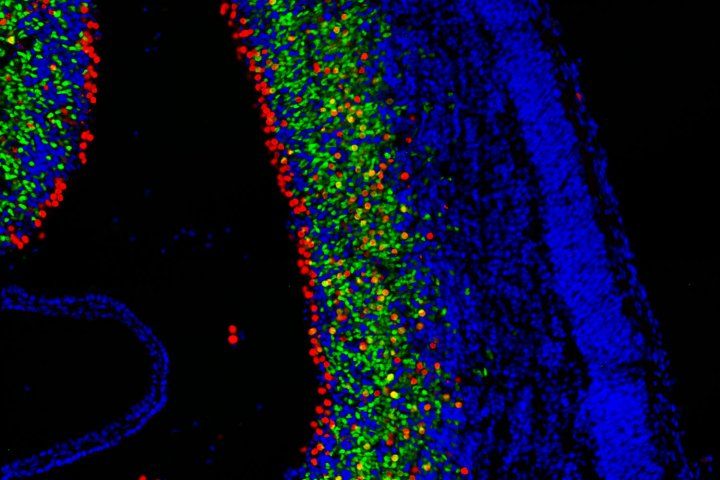
Mouse brain showing genetically modified cells stuck in the neural precursor stage (red, yellow) and unable to progress to become neurons. Image credit: Ralitsa Petrova, PhD, Panagiotakos Lab, UCSF
The brain - the central processor of all our thoughts, emotions, motivations and drives - is certainly our most elaborate organ, and is sometimes considered to be one of the most complicated objects in the universe. So it is one of the wonders of nature that this organ of ultimate complexity builds itself during embryonic development out of a simple tube of stem cells known as neural progenitors.
How exactly this self-construction occurs is the central preoccupation of developmental neuroscientists like Georgia Panagiotakos, PhD, a Sandler Faculty Fellow in the Department of Biochemistry and Biophysics at UCSF. Beyond its appeal as a core scientific mystery, this question also has major implications for neurodevelopmental disorders, in which certain steps in the brain's self-assembly go awry, producing the wrong types of cells in the wrong numbers or wrong location and throwing off normal circuit function.
In a new study, published online February 18, 2021 in Genes and Development, Panagiotakos and collaborator Gerald Crabtree, MD, professor of pathology and of developmental biology at the Stanford University School of Medicine, have identified a central switch that appears to control when neural progenitor cells stop multiplying and start differentiating into mature neurons. This critical step in brain development has to be timed just right to set up the elaborate layered circuitry of the neocortex and is known to be influenced by a wide array of signals within the brain.
"One of the things I find most fascinating about brain development is that these progenitors are sitting in an environment where they are receiving signals that promote proliferation," said Panagiotakos, a member of the UCSF Kavli Institute for Fundamental Neuroscience and the UCSF Eli and Edyth Broad Center for Regeneration Medicine and Stem Cell Research. "How, in the face of all these competing and converging signals, do progenitors generate daughter cells that exit the cycle of cell division at precisely the right time to make a neuron? To my mind, how these decisions get made is one of the most fundamental questions in stem cell biology."
Led by Simon Braun, PhD, a former postdoctoral scholar in Crabtree's lab and Ralitsa Petrova, PhD, a former postdoctoral scholar in Panagiotakos's group, the researchers conducted an elaborate series of experiments over the past seven years, which involved microscopic injections into the progenitor-lined ventricular spaces deep in the brains of mouse embryos to precisely alter and study the molecular machinery of neural differentiation.
The team found that in order for progenitors to commit to the decision to become neurons, a protein complex called BAF must swap out a set of progenitor-specific subunits and replace them with neuron-specific ones - like swapping out a molecular SIM card. If the team deleted one of these subunits and didn't replace it, the cells get "stuck" in the progenitor state and didn't develop into neurons.
The BAF complex is able to rearrange the 3D shape of DNA, as it coils in the cell nucleus, to determine which specific parts of the genome are available for use by a particular cell, and which parts are packaged away. (This process is a big part of why our bodies can have such a wide diversity of cell types, despite each containing exactly the same genetic code.)
In their new study, the researchers showed that at the point of differentiation BAF's subunit switch triggers a wide array of changes in which segments of DNA are exposed - in particular, archiving DNA regulatory elements involved in maintaining progenitor division and unpacking other elements needed for the cell's differentiation into a mature neuron.
"The BAF complex is fascinating because it enables large-scale changes in gene expression - it can change and coordinate the output of a lot of genes at once," Panagiotakos said. "We think that BAF may be a developmental checkpoint just before cells make the decision to differentiate into a neuron. Other incoming developmental signals converge on this switch, and if it's missing or dysfunctional, other signals are unable to execute their functions."
This precise coordination is just what one would expect would orchestrate the widespread and carefully timed changes seen in brain development, but could also have wide-ranging implications if this central decision point goes awry.
"Understanding the precise molecular mechanisms used by BAF to control neuronal circuit formation and function may lead to new treatments for a number of neurodevelopmental diseases," said Crabtree, a Howard Hughes Medical Institute investigator.
The genes that code for BAF are among the most frequently altered in people with conditions such as autism and intellectual disability, and other mutations linked to developmental brain disorders also affect signaling pathways that appear to converge on BAF. On the other hand, changes in one of the BAF genes has also been linked to exceptional intellectual ability, suggesting that the BAF complex may have played a broader role in the evolution of human intelligence, the authors say.






